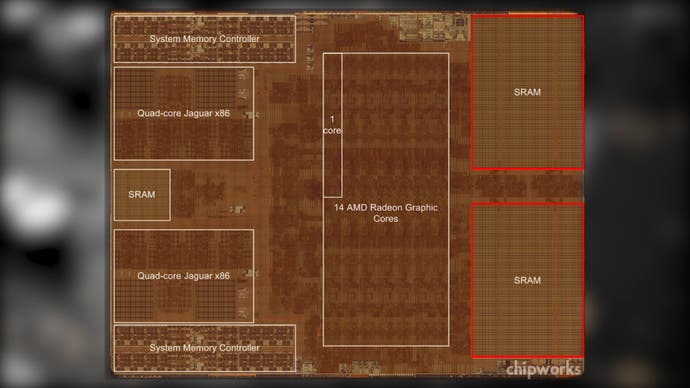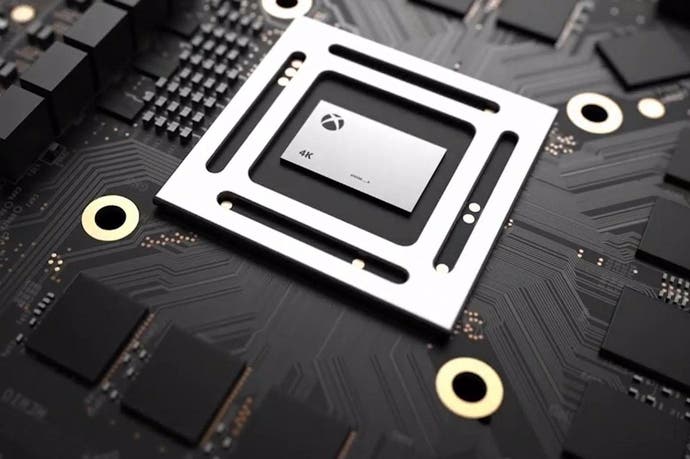The race for 4K: how Project Scorpio targets ultra HD gaming
New spec details emerge: ESRAM is gone from the new Xbox.
The race for 4K gaming has begun. PlayStation 4 Pro is in the marketplace, and while success in supporting ultra HD gaming varies dramatically between releases, an established series of techniques is in place that is already capable of effectively servicing a 4K resolution with a comparatively modest level of GPU power. In the wake of its E3 2016 reveal for the new Project Scorpio console, Microsoft began to share details with developers on how they expect to see 4K supported on its new hardware. A whitepaper was released on its development portal, entitled 'Reaching 4K and GPU Scaling Across Multiple Xbox Devices'. It's a fascinating outlook on Microsoft's ultra HD plans - and it also reveals more about the Scorpio hardware itself. For starters, Xbox One's contentious ESRAM is gone.
A small, but ultra-fast array of embedded static memory integrated into the Xbox One processor itself, ESRAM was the high-bandwidth scratchpad designed to mitigate for the lower-speed DDR3 system RAM on which the Xbox hardware relied. An evolution of the eDRAM attached to the Xbox 360 GPU, ESRAM is massively fast but suffers from one major shortcoming - the lack of it. Microsoft's whitepaper categorically rules out ESRAM for Scorpio, while at the same time suggesting that developers continue to support it to ensure strong performance on legacy Xbox One hardware.
"ESRAM remains essential to achieving high performance on both Xbox One and Xbox One S," the whitepaper reveals. "However, Project Scorpio and PC are not provided with ESRAM. Because developers are not allowed to ship a Project Scorpio-only SKU, optimising for ESRAM remains critical to performance on Microsoft platforms."
The whitepaper suggests that the process of render target 'aliasing' - which suits Xbox One and achieves considerable memory saving - continues, but on PC, those targets can now exceed the older hardware's 32MB limit, as you would expect in moving from 900p or 1080p to ultra HD buffers. Adopting strategies that favour ESRAM are good for other platforms too - Microsoft says it saves memory, favours lower-end PC cards with limited VRAM and makes it easier to hit 4K and 'boost visual quality settings'.
In our post-E3 Project Scorpio spec analysis, we assumed that ESRAM was a thing of the past for Scorpio, but many believed that it would remain on the processor die in order to maintain compatibility with Xbox One titles. The theory was that the system's 320GB/s memory set-up could not match ESRAM's lower latency. The Microsoft whitepaper mentions nothing about ESRAM's latency advantages - simply stating that Scorpio's far higher system memory bandwidth outstrips ESRAM's wide bandwidth capabilities.
There are other clues as to Scorpio's final hardware set-up within the whitepaper. The six teraflop GPU is once again confirmed, with the GPU's compute power rated at around 4.5 times the capabilities of Xbox One. Four times more L2 cache is also confirmed - a new detail that does not tell us that much, except that that the GPU architecture in Scorpio is at least as modern as AMD's Polaris line. Based on our discussions with Mark Cerny on PS4 Pro, we can reasonably assume that Microsoft can customise its GPU core just as Sony did, with access to Radeon roadmap features up to - and perhaps beyond - AMD's upcoming Vega architecture. Microsoft gives away little here, other than to confirm that delta colour compression (DCC) is a part of the Scorpio GPU feature set, just as it is in PS4 Pro.
It's the application of Scorpio's power that is the focus of Microsoft's whitepaper, and other hints about the hardware make-up of the console are few and far between. In the wake of CES, there is renewed speculation that Scorpio may feature more advanced Zen CPU cores. However, a throwaway comment within the Microsoft whitepaper on how developers may wish to use Scorpio's capabilities again makes this seem unlikely.
"We acknowledge that developers may not wish to spend all of the additional GPU resource of Project Scorpio on resolution, and this is not mandated," the paper says. "To make the best games possible, developers will inevitably spend GPU resource on other quality improvements such as higher fidelity shadows, reflections, texture filtering and lower draw distances. Another option developers might consider is frame-rate upscaling - running graphics at 60Hz but the CPU at 30Hz and interpolating animation."
PlayStation 4 Pro has offered several titles with high performance modes running on unlocked frame-rates - and notably none of them has managed to double performance consistently from 30fps to 60fps. Microsoft makes no claim that Scorpio is able to do so either and instead suggests a compromise - running GPU elements at twice the speed, while CPU-bound elements are interpolated. A move to far more powerful Zen cores would almost certainly make such advice redundant. We're not aware of any console titles that use this frame-rate upscaing technique - though there was a really impressive Force Unleashed 2 tech demo back in the day - but at the very least, the comment reaffirms our belief that Scorpio's CPU technology has not moved on in step with its GPU.

And to be fair, Microsoft has never suggested otherwise. It confirmed eight CPU cores out of the gate, suggesting a higher-clocked version of its existing CPU technology and all of its messaging has been about running existing game engines at 4K resolution with HDR rendering. The whitepaper we've seen primarily concentrates on how this is possible. A 4.5x boost to compute power suggests that 1080p engines will scale nicely to 4K on Scorpio, but the reality is that many Xbox One titles render at a 900p base resolution. The leap to 4K therefore becomes a 5.76x increase in pixel-count and at the same time, developers may not wish to spend GPU power on pixels alone.
However, the fact that the GPU does more than compute pixels can help in the quest to render at 4K, and not all surfaces are tied to display resolution. The whitepaper also reveals that rasterisation efficiency increases in line with resolution - an interesting metric shared by Microsoft is that an unnamed first-party title running at 1080p sees the number of pixels processed increased by a factor of 3.5x in the leap to 4K, not the 4x we would assume.
The platform holder also recommends several techniques in improving efficiency without unduly impacting image quality, citing half-resolution and 'sparse' rendering as two examples. Half-resolution is a technique we've seen before, where intensive GPU effects are cut down in size to effect efficiency savings, sitting within a full resolution framebuffer.
"Half-resolution rendering is typically used for transparencies and screen-space effects, SSAO, SSR, and perhaps even shadow accumulation, global illumination and non-important local lights," the white paper reveals. "On Project Scorpio, a half-resolution effect rendered at 1080p and bilaterally up-sampled to 4K could look as good or better than the same effect rendered at full resolution on Xbox One. For example, on Xbox One, the effect is produced at full resolution, say 900p, but on Project Scorpio, the effect is produced at 1080p, which is half resolution."
In effect, Microsoft is saying that half-res effects run at 1080p in a 4K framebuffer will look better than a native 900p, which is difficult to argue with. The second major technique it advocates is 'sparse rendering' - which is better known in the post-PS4 Pro era as checkerboarding. Not only does Microsoft advocate the same technique for Scorpio, it also cites the same impressive work by Ubisoft seen in Rainbow Six Siege - to the point where the exact same presentation shown to me by Mark Cerny a few months back is referenced in the whitepaper. Of course, the technique has evolved further since then, with the same core technology also used in the PC and PS4 Pro versions of Watch Dogs 2, with exceptional results.

Microsoft also strongly advocates the use of dynamic resolution scaling within the whitepaper, and it describes it as titles aliasing "a vector of render targets in the same virtual address space, and at runtime choose[s] which to index, increasing or decreasing resolution based on whether the GPU is completing early or late. Thanks to DirectX12, this aliasing can be achieved on all of PC, Xbox One, Xbox One S and Project Scorpio."
On the face of it, the in-depth discussion of techniques like this may be suggesting that Scorpio isn't the 'true 4K' console that Microsoft marketed it as at E3 2016. But the practical reality is that the document confirms that at least one first-party 1080p title has transitioned relatively easily to native 4K (our best guess would be the Forza Motorsport engine is the technology in question here), and accepts the reality that GPU resources aren't always best spent on precision pixel-work at ultra HD resolutions.
Of course, the reality is that the techniques outlined in the whitepaper have been battle-tested by PlayStation 4 Pro. Titles like Rise of the Tomb Raider, Horizon Zero Dawn and Days Gone have validated sparse/checkerboard rendering up to 2160p, while Call of Duty Infinite Warfare employs virtually all the techniques Microsoft discusses in some way, shape or form. Scorpio's additional horsepower - combined with more developer experience by the time it launches - should also lead to fewer of the basic 1440p ports we've seen on PS4 Pro.
But what the whitepaper doesn't cover could also prove instrumental in Scorpio delivering more titles that run effectively on 4K screens. In our original Scorpio spec analysis, our primary concern was the size of the processor based on the six teraflop GPU, where a 56 or 60 compute unit chip seemed most plausible. We now know that AMD's next-gen Vega GPU boasts considerably improved frequencies - and the faster it runs, the fewer CUs are required to hit the 6TF target. Just 40 CUs at 1.18GHz could deliver Scorpio's stated 6TF, or 44 at 1.07GHz. On top of that, Vega's use of a tile-based rasteriser (widely seen as the key to Nvidia's performance lead in its Maxwell GPU technology) could also yield dividends in delivering a more capable 4K console.
But to clear, this is speculation based on what we now know about new Radeon features open to Microsoft. The whitepaper we've seen - dated to just after Scorpio's E3 reveal - only confirms no ESRAM, boosted L2 cache and support for memory compression technology. Beyond that, all we have to go on is Microsoft's stated 320GB/s bandwidth, eight CPU cores - plus a motherboard rendering strongly suggesting 12GB of GDDR5 memory. How the final spec will shape up remains to be seen, but from the whitepaper details to the Vega enhancements available to Microsoft, we should be a seeing a highly capable 4K contender.


